
January 2017
Standing Rock
and the Revolutionary
Fight for Native American Rights
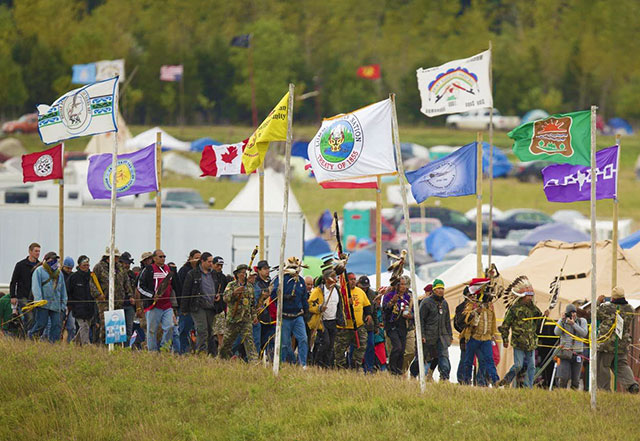
Tribal flags at entrance to Oceti Sakowin camp north of Standing Rock Sioux Reservation in September. (Christopher Juhn for Minnesota Public Radio News)
Over the past nine months, hundreds and then thousands of Native Americans from around North America converged on the Standing Rock Indian Reservation to stand with the Sioux “water protectors” in resisting the attempt to push the Dakota Access Pipeline (DAPL) through their lands. More than 300 of the 567 federally recognized tribes were present, signaled by the rows of tribal flags at the Oceti Sakowin (Great Sioux Nation, or Seven Council Fires) camp. It has been the largest mobilization to defend Indian rights since Sitting Bull at the head of several thousand Lakota Sioux, Cheyenne and Arapaho tribes smashed the U.S. Seventh Cavalry under General George Custer at the 1876 Battle of the Little Bighorn (known as the Greasy Grass River by the Lakota). The battle at Standing Rock is not just over a pipeline, it is over centuries of oppression.
Elsewhere in the U.S., the issue has often been posed as an environmental fight over building pipelines. But as an article on the New York Times (7 November) blog Dot Earth headlined: “The Core Issue in the Dakota Pipeline Fight is Sioux Rights, Not Oil.” The author, Arnold Revkin of the ProPublica website, wrote about calls to “keep it in the ground” that this “might work symbolically and energize progressives, but oil is a global commodity and will find a path from wells to markets as long as demand persists.” Rather than a fight over fossil fuels, the battle of the Standing Rock Sioux is about confronting the systematic dispossession of the Indian peoples dating back to the first European settlement of the American continent. The unparalleled Native American solidarity and widespread public support for their cause may spark a broader struggle for Indian rights. But to win this must be a class battle against all the capitalist rulers.1
The Standing Rock Sioux Tribe rightly insists that the U.S. must deal with it not as subjects but through negotiation between governments. Since Native American peoples were classified as nations in the modern system of nation-states, their relations with the United States have been set down in treaties. These agreements have repeatedly been ripped up, but the treaties themselves only codified the land theft as American capitalism marched across the continent, whether in the form of settlers, gold miners, railroads or pipelines, backed or spearheaded by the U.S. Army. The history of broken treaties goes back to the foundation of the republic, and continues to this day. The owners of Dakota Access, the state of North Dakota and the Army Corps of Engineers all hold that the pipeline does not cross the territory of the Standing Rock Indian Reservation, and therefore the tribe has no right to veto the project. But in fact it’s on stolen Indian lands.
A century and a half ago this was all formally recognized by Washington as Indian country. As the Tribe asserts in its suit against the Corps, “the 1851 Treaty of Fort Laramie included extensive lands that would be crossed by the proposed pipeline.” While a second (1868) Treaty of Fort Laramie established a Great Sioux Reservation covering all of western South Dakota, the lands to the north were declared “unceded Indian territory ... [that] no white person or persons shall be permitted to settle upon or occupy.” Soon enough, in 1874 Custer announced the discovery of gold in the Black Hills of South Dakota, and then launched a war to drive out the Sioux. Despite Sitting Bull’s stunning victory over Custer, the war resulted in an 1877 treaty seizing the Black Hills. In 1889 the U.S. broke up the Great Sioux Reservation into five small tracts, and the next year tribal police on the U.S. payroll killed Sitting Bull at Standing Rock.
The reservations, while a last toehold of Indian territory, are a historical injustice, meant to confine the survivors of the American bourgeoisie’s destruction and displacement of the native population. The birth of industrial capitalism in this country required the exploitation of vast tracts of land that indigenous people formerly inhabited and used for hunting grounds and agriculture. The little parcels today inhabited by various tribes are the end product of a string of crimes – and the violation of the land rights of Native Americans continues. In 1958, the U.S. Army Corps of Engineers seized nearly 200,000 acres of land from the Standing Rock and Cheyenne River reservations, removing the people in order to build the Oahe Dam as part of a Missouri River flood control program. Now the Corps and the DAPL claim the right to put a pipeline across Sioux lands.
A History of Massacres and Broken Treaties
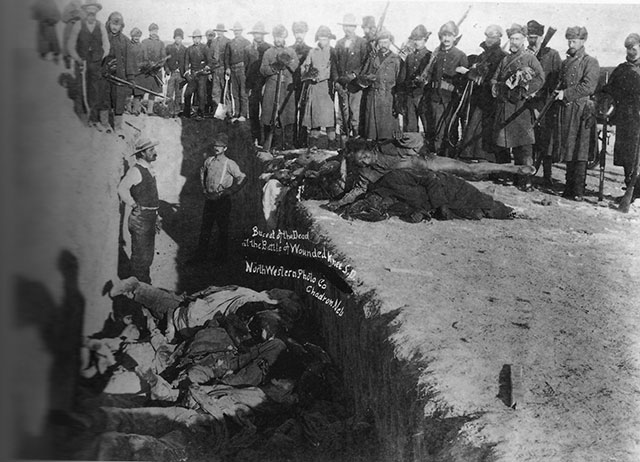
Soldiers throw bodies of Lakota Sioux Indians killed in the 29 December 1890 massacre at Wounded Knee, South Dakota in mass grave. Twenty Congressional medals of honor were obscenely awarded to participants in this mass murder. (Northwestern Photo Co., from Library of Congress)
Behind this latest aggression there is a whole history of massacres and broken treaties. To the extent most Americans know anything of the Sioux (aside from romanticized versions of “Custer’s Last Stand”), they may have heard of the Wounded Knee massacre of 1890, when U.S. Seventh Cavalry soldiers slaughtered as many as 300 Lakota Sioux. They were fleeing, fearing reprisal by the state after some Indian police on the U.S. payroll were killed as they tried to arrest, and ended up assassinating, Chief Sitting Bull. (The U.S. feared he would join the Ghost Dance spiritual revivalist movement.) As the Lakota neared the Pine Ridge Indian Reservation, they were surrounded by soldiers who attempted to take their arms. Warriors were shot point-blank and their families mowed down in tipis by Hotchkiss rapid-fire guns. Those who escaped were pursued across the prairie and finished off. Even the butcher General Nelson Miles called it “abominable” and a “horrible massacre of women and children.”
Some may also know of the Wounded Knee siege of 1973, for example from seeing Robert Redford’s documentary film, Incident at Oglala (1992). Two hundred Oglala Lakota and supporters of the American Indian Movement (AIM) had occupied the town of Wounded Knee, South Dakota – the same place as the 1890 massacre. They were protesting the U.S. government’s failure to fulfill treaty obligations, and demanding impeachment of the Pine Ridge Reservation president. In response, the FBI put the town under siege for 71 days, killed two demonstrators and disappeared civil rights activist Ray Robinson. Later, AIM activist Leonard Peltier was framed for the 1975 shooting of two FBI agents at Pine Ridge. The feds manufactured evidence against Peltier, hid bullet tests proving his innocence, presented false testimony obtained by torture, and lied to the jury. Forty years later, he is still in jail.2 We demand Leonard Peltier be freed, now!
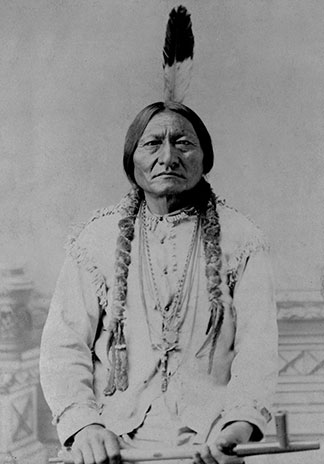 Chief Sitting Bull smashed
treaty-buster Custer at the Battle of Little Big Horn in 1877,
was murdered by U.S. in 1890 at Standing Rock. (Library of Congress)
Chief Sitting Bull smashed
treaty-buster Custer at the Battle of Little Big Horn in 1877,
was murdered by U.S. in 1890 at Standing Rock. (Library of Congress)The history of the genocidal push to devastate the American Indian population goes back to the “rosy dawn of capitalist production,” as Marx ironically put it. That drive includes erasing the history of dispossession of the Native Americans, and of Indian resistance. Every year, the feast of Thanksgiving is celebrated in November. Schoolchildren are taught that this was a day of brotherhood and gratitude when the pilgrims were saved from starvation by the Indians at Plymouth, Massachusetts. Such a feast did occur in 1621, but the official proclamation of Thanksgiving celebrated a 1637 massacre by English and Dutch mercenaries against the Pequot Indians. In what is present-day Mystic, Connecticut 700 Native Americans were slaughtered by these colonial thugs – and then-governor of Massachusetts John Winthrop proclaimed “a day of public thanksgiving to God for his great mercies in subduing the Pequots.”
American schoolchildren learn of Daniel Boone as an explorer, but not about his role in leading settlers into what is now Kentucky, where they were resisted by Indian nations. This was the start of Lord Dunmore’s War (1774), named after the colonial governor of Virginia, which pushed the Shawnee Indians beyond the Ohio River. Such acts of aggression drove many Indian tribes into the arms of the British during America’s 1776 war for independence. In 1779, on the orders of President George Washington, the Sullivan Expedition was sent into Pennsylvania and western New York to decimate the Iroquois Confederacy. Their orders were to burn all villages, crops and livestock. The result was starvation for thousands through loss of agricultural land. This marked the definitive subjugation of the Iroquois, whose pre-class society (“primitive communism”) was studied by Lewis Henry Morgan. His book Ancient Society (1877) was a main source for Friedrich Engels’ Origin of the Family, Private Property and the State (1884).
The restless westward expansion of the newly formed United States soon sent settlers and the U.S. Army across the Ohio River. Although the area was ceded to the U.S. by Britain in the 1783 Treaty of Paris, it was populated by tens of thousands of Native Americans. The Western Confederacy led by Shawnee and Miami Indians scored some resounding victories, notably in the Battle of the Wabash (1791) where the U.S. invaders lost almost 1,000 troops. But eventually the Indian forces were overpowered and lost the Northwest Indian War (1785-1795). This didn’t stop Native American resistance, however. The next chapter was Tecumseh’s War (1811) in the Indiana Territory. The Shawnee leader objected to the Treaty of Fort Wayne, when “moderate” chiefs gave up huge tracts. Despite Tecumseh’s eloquence, calling on Indians to awaken from “the sleep of slavery,” his tactical success (along with the British) in gaining the surrender of Detroit, and future president William Henry Harrison’s dubious claim to have won the Battle of Tippicanoe, Tecumseh failed to unite the tribes and was killed as a British ally in the War of 1812.
Then came Andrew Jackson’s infamous “Trail of Tears.” Under the Indian Removal Act of 1830 and precipitated by the discovery of gold in Georgia, the Cherokee, Muscogee, Seminole, Chickasaw and Choctaw peoples were forced to sell their lands east of the Mississippi River and move to present-day Oklahoma. The Seminoles fought two wars of resistance, joined by black slaves who destroyed coastal plantations, lasting from 1832 to 1842. Those Seminoles who were not forcibly relocated to the west of the Mississippi retreated into the Everglades, refusing to sign a peace treaty with the U.S. The Cherokee also refused to leave and were marched at gunpoint in groups of 1,000 on a thousand-mile trek fraught with disease, starvation and exposure to brutal weather. By 1837 some 46,000 Native Americans had been expelled from their homelands in the South, and 6,000-10,000 died on the way.
While Harrison and Jackson were open reactionaries, few know about Abraham Lincoln’s brutal repression of the Sioux Uprising of 1862 in southern Minnesota during the Civil War. Provoked by U.S. confiscation of their lands, failure to pay annuities, and famine due to hunting by encroaching white settlers, the Dakota Sioux in the Minnesota River valley rose up in rebellion. This led to a series of battles between the Sioux and the U.S. Army. It ended with the mass hanging of 38 Native Americans in Mankato, Minnesota on 26 December 1862, the day after Christmas. It was the largest single execution in American history. Even so, Minnesota governor Alexander Ramsey wanted to execute 300 Sioux. That same day, the “president who freed the slaves” officially made a national holiday of Thanksgiving, which celebrated the 1637 massacre of the Pequots. An expedition led by ex-governor Henry Hastings Sibley pushed the retreating Dakota Sioux into the Dakotas, where the next year 300 to 400 were killed in the Inyan Ska (Whitestone) Massacre.
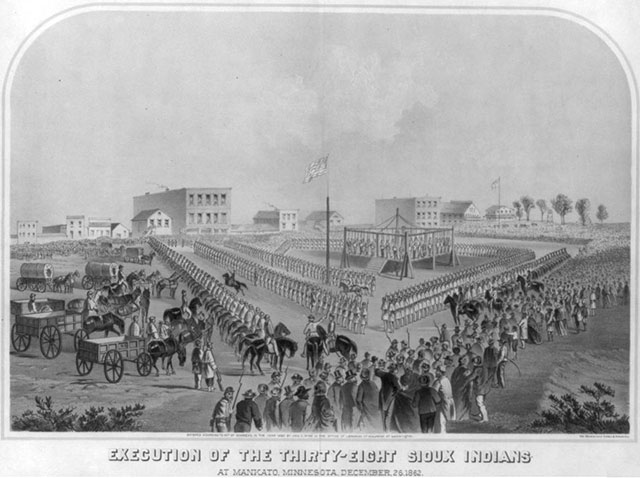
Drawing of mass execution of 38 Sioux at Mankato, Minnesota in December 1862. President Lincoln personally selected those to be hung. (Christopher Childs/Frank Leslie's Illustrated Newspaper, from Library of Congress)
In his famous Custer Died For Your Sins: An Indian Manifesto (1969), Native American activist and Standing Rock Sioux member Vine Deloria Jr. traces the succession of broken treaties back to the Treaty of Delaware of 1778. Deloria outlines the official promises made by the U.S. to American Indians – to never encroach on land, allow for self-governance, guarantee hunting and fishing rights, etc. – and how U.S. capitalism’s need for resources led to these promises being broken. Then when the reservation system was introduced, the federal Bureau of Indian Affairs (BIA) instituted brutal controls to “civilize” the Indians. The second (1868) Fort Laramie Treaty called for Lakota children to be given an “English education.” At the end of the 19th century, mission schools on the reservations were replaced by Indian boarding schools, where children were taken from their families, physically abused, prohibited from using their native languages and religion, and forced to learn English and practice Christianity.
The 1887 Dawes Act aimed at breaking up communally owned tribal land by parceling it out in individual “allotments.” It destroyed Indian communities and opened the way for massive land-grabs by white settlers and corporations. The Commissioner of Indian Affairs Thomas J. Morgan in his 1889 report on the BIA spelled out the intent: “The Indians must conform to the white man’s ways, peaceably if they will, forcibly if they must. They must adjust themselves to their environment and conform their mode of living substantially to our civilization. This civilization may not be the best possible, but it is the best the Indians can get. They cannot escape it and must either conform to it or be crushed by it.” In the next year’s report he added: “It has become the settled policy of the government to break up reservations, destroy tribal relations, settle Indians upon their own homesteads, incorporate them into the national life, and deal with them not as nations or tribes or bands, but as individual citizens.”3
To top it off, in 1953 Congress passed the Termination Act, seeking to end what few responsibilities the federal government still had to the Indians living on reservations, and insert them into urban populations. In An Indigenous Peoples’ History of the United States (2014), Roxanne Dunbar-Ortiz noted that during the Termination period, Eisenhower’s Commissioner of Indian Affairs was one Dillon S. Myer – the same official who oversaw the detention of Japanese Americans in U.S. concentration camps during World War II. Then came the Pick-Sloan Missouri River Basin flood-control program which consisted of permanently flooding Indian tribal lands. Native Americans were moved from the food-rich bottom lands, their aboriginal homelands, to the barren plains above the river valley, where clay soils made agriculture almost impossible. Although required by the 1944 law to replace the infrastructure (roads, water systems, schools, community facilities), the Army Corps of Engineers failed to do so.4
And now the Dakota Access Pipeline continues the assault on the lands of Native Americans, this time threatening the Sioux at Standing Rock. The company has the enthusiastic support of the North Dakota state government and as usual the backing of the Corps of Engineers.5 Although the DAPL has temporarily been put on hold by the Obama administration, this will soon be replaced by a new regime of Big Oil and hard cops. Court suits can perhaps delay the day of reckoning, but since time immemorial the law is stacked against the Indians and in favor of the corporations.
Native American Rights and Socialist Revolution
In any fight it is crucial to know who are your friends, and who is the enemy. For starters, it is necessary to dispel dangerous illusions in the courts and federal government as potential allies. Marxist theory holds, and five centuries of Indian history prove, that the state defends the interests of the ruling class against the exploited and oppressed, no matter who heads the government of the day. The battle over the DAPL shows that whether under Obama or now Trump, Native Americans are up against the full force of the repressive and administrative apparatus which exists to enforce the interests of the capitalist class. To prevail against such a powerful enemy, it is necessary to mobilize an even greater force: that of the multiracial, multiethnic working class which makes this society run, together with doubly oppressed African American, Latino, Asian and Native American people and immigrants, and all defenders of democratic rights.
From the outset, the leaders of the Standing Rock Tribe have looked to the courts and the Obama administration. At the camp on the banks of the Cannonball River, wrote tribal chairman David Archambault II, “Our elders of the Seven Council Fires, as the Oceti Sakowin, or Great Sioux Nation, is known, sit in deliberation and prayer, awaiting a federal court decision” (New York Times, 25 August). When the Department of the Army finally refused an easement to drill under the Missouri River, pending investigation of environmental impact and alternative sites, the Standing Rock Sioux Tribe issued a statement to stress that “we are not opposed to energy independence … or national security concerns,” and to “commend with the utmost gratitude the courage it took on the part of President Obama … to take steps to correct the course of history and to do the right thing.” Then Archambault told protesters to dismantle the camp and go home.
But some of the “water protectors” refused to leave. LaDonna Bravebull Allard, on whose land the Sacred Stones Camp was built, declared: “The chairman does not tell us what to do. The chairman is not in charge of the camp…. We came to fight a black snake,” she said, referring to the pipeline. “Until it’s dead, we stand” (Guardian, 6 December). This dispute reflected deep divisions on the reservation and among the Native American population generally. The Standing Rock elders declared that the Red Warrior Society, including militant Indian youths who began the protests, should leave. The Red Warriors replied that they were leaving because tribal leaders with their “peace policing” and “constant slinging of arrows … are not ready to embrace a world view that upholds decolonization and revolution.”
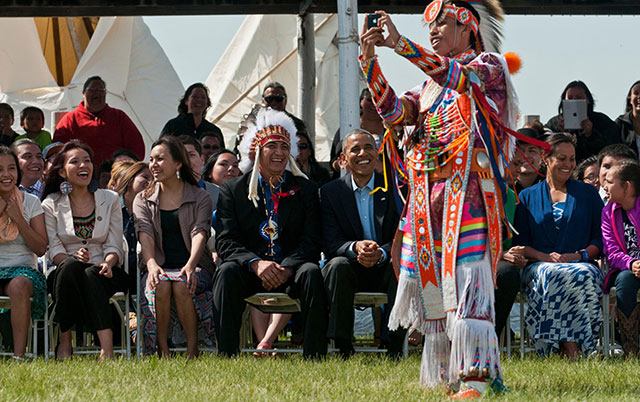
Indian leaders have strong links to Democratic Party and Obama administration. (Above) Standing Rock Tribe chairman David Archambault II with Barack Obama during Cannon Ball Flag Day celebration, 13 June 2014. (Gabriella Demczuk/The New York Times)
Certainly not. In fact, tribal leaders have close ties to the Obama administration and the Democratic Party. David Archambault II’s sister, Juliette Archambault Gillette, worked at the White House for six years as Obama’s special assistant for Native American affairs. She arranged the annual White House Tribal Nations Conference and also the June 2014 visit of the Obamas to Standing Rock. Another prominent Standing Rock Sioux, Chase Iron Eyes, who called for water protectors to stay, ran for Congress in the November elections, while Marlo Hunte-Beaubrun ran for the Public Service Commission (which approves pipelines), both on the Democratic-NonPartisan League Party ticket. In fact, the only North Dakota counties won by the Democrats were Sioux (Standing Rock Reservation) and Rolette, site of the Turtle Mountain Reservation of Ojibwe (Chippewa). But the Democratic Party represents the interests of capital and U.S. imperialism. It is the class enemy of Native American workers and youth.
Capitalism has fostered class divisions among the 5.2 million American Indians. Some tribal authorities profit from casinos, which have become a major source of revenue ($26.5 billion in 2009, although much of that goes to pay off bank loans), and in some notorious cases a history of sweetheart deals with mining companies. As a result of private landownership, on the Fort Berthold Reservation in the heart of the Bakken oil patch a huge gap has opened up between those who have oil leases or oil-related businesses and those who don’t. The tribal leadership there has been rent by corruption, crime and murder.6 Meanwhile unemployment on the Standing Rock Reservation is around 60% (compared to 2.6% in North Dakota as a whole) and the official poverty rate around 40%. The rates of methamphetamine addiction, alcoholism and suicide among Native Americans are almost twice as high as for other ethnic groups. While many factors are cited to explain this, one stands out: the lack of jobs.
It will take a revolution to do away with these afflictions, which will continue, pipeline or no. But what kind of revolution? In the 1960s, the rise of the American Indian Movement and struggles for Native American rights reflected the broader radicalization of the civil rights, black power, New Left, antiwar and radical women’s movements. The 19-month occupation of Alcatraz in 1969-71 by AIM and “red power” activists, the 1970 Thanksgiving AIM protest at Plymouth Rock, the 1972 Trail of Broken Treaties caravan sponsored by AIM and others, and the 1973 occupation and siege of Wounded Knee drew attention to the brutal realities of oppression but were not just “Indian” causes. But those struggles ran up against a brick wall, and with defeat came a political degeneration into identity politics and linking up with dissident petty-bourgeois and bourgeois parties, from the left-populist Peace and Freedom Party (Dennis Banks) to the ultra-capitalist Libertarian Party (Russell Means).
The radical American Indian Movement was relatively few in number. The Native American mobilization for Standing Rock is far larger, in the biggest fight for Indian rights in 150 years. But contrary to scaremongering by county and state officials about a dangerous “out-of-state militant faction” that was “escalating their violent tactics,” the politics of the pipeline protests are far from radical. This is one reason why they have broad liberal support, and also why they cannot defeat concerted repression. Yet with their scope, they prominently pose the issue of liberation of the oppressed Indian population, and the need for a program of revolutionary class struggle, joined with African Americans, Latinos, immigrants and others behind the power of the multiracial, multiethnic working class. It is the task of the revolutionary Marxists (Trotskyists) to put forward such a program, which alone can point the way to victory over the combined forces of capital.
In the 1960s and early ’70s, radical Native American groups such as AIM, as well as some pseudo-Marxist organizations, put forward a kind of pan-Indian nationalism, a counterpart to the black nationalism they also advocated. Both were and are dead-ends, based on a false analysis of the nature of black and Indian oppression. African Americans are subjugated as an oppressed race-color caste at the bottom of bourgeois society. From the time of slavery, black labor was integral to the overall U.S. economy. For a time after the Civil War, when freed slaves without land became sharecroppers, tenant farmers and smallholders, there was some possibility of a national development in the “black belt” across the South. But ever since the Great Migration of rural black people to Northern industry in World War I, any talk of a black nation in the U.S. is a myth, serving to divert black workers from their vanguard role in a socialist revolution.
American Indians, on the other hand, were treated as separate peoples, formalized in the term “nations” with whom treaties were “negotiated” at gunpoint. The native peoples were pushed into increasingly marginal regions by military aggression and the relentless expansion of immigrant settler population as the frontier moved westward. After the decimation of the Native American population through massacres, hunger and disease, the remaining small and geographically separated populations are not a nation in the Marxist sense of having a common territory, economy, culture and language. The dream of a pan-Indian nation is just that – a dream, and a product of Native American intellectuals and activists living in urban areas. AIM did not come out of the reservations but was founded in 1968 in a fight against police harassment in the Minneapolis ghetto, inspired by the Black Panther Party.
AIM called for “self-determination for free peoples,” in the words of Dennis Banks. Historically, as Bolshevik leader V.I. Lenin insisted, self-determination means independence. But since the material basis for an Indian nation is lacking, the term was redefined to mean “Re-establishment of reservation sovereignty and self determination” – replacing the dictatorship of the Bureau of Indian Affairs with a kind of autonomy. But with very partial exceptions, the reservations are economically unviable, designed to imprison the Native American peoples and ensure tribal dependence on Washington. So in practice, the radical Indian program focused on welfare demands on the structures of capitalist domination. Thus Vine Deloria’s 1969 “Indian Manifesto” called for “the Department of the Interior to redefine its service function” and stated that “The corporation serves as the technical weapon by which Indian revivalism can be accomplished.”
Under capitalist rule, the claims of Indian “nation-building” will have not only a utopian but often a reactionary content. In Arizona, the Navajo Nation has a long, bitter conflict over land use with the Hopi Reservation, which it completely surrounds. In Oklahoma, when the Nixon administration in 1971 cynically called for Indian “self-determination,” the Cherokee Nation reorganized its government and elected W.W. Keeler as chief. Keeler was a top-level capitalist, president of Phillips Petroleum. Based on oil wealth, the Cherokee Nation Businesses holding company owns companies in gaming, construction, aerospace, technology, manufacturing, real estate and health care, with an annual economic impact on the state of over $1 billion. And this corporate “nation” has acted in typical capitalist fashion. In 2007 it canceled the tribal membership of 1,500 descendents of black freedmen and intermarried whites who had for generations been considered Cherokee.
Meanwhile, already in the 1970s and more so today, a majority of the Native American population lives in urban areas (55% in 1970, 70% by 2010) where they are largely concentrated in poor neighborhoods. But, as a New York Times (14 April 2013) article noted: “while many black migrants [in the WWI Great Migration] found jobs in meatpacking plants, stockyards and automobile factories, American Indians have not had similar success finding work.” There are significant exceptions: Mohawk and Iroquois iron workers (“sky walkers”) play a key role in the construction of Manhattan skyscrapers, and Native American workers were on the front lines of the bitter Phelps-Dodge copper strike of 1983. But poverty levels of American Indians in the cities range up to 45% in Minneapolis, where the jobless rate in the only public housing project in the U.S. giving preference to Native Americans is over 65% – as high as on the most impoverished reservation. There are also high levels of gang violence and racist attacks. Native American project administrators respond just as their white counterparts, threatening to expel residents who can’t find a job.
Even so, as AIM co-founder Clyde Bellecourt, remarked, many young Indians “come here [to urban areas] and they get job training and don’t want to go back to the reservation.” Just as you can’t keep rural youth down on the farm no matter how many 4-H or FFA programs you have, they can’t keep Indian youth on the reservation: harsh as the economic realities of the urban ghetto are, the lure of the big city and bright lights prevails. Meanwhile, talk of “empowerment” by increasing “diversity” among the rulers is a phony. Minneapolis has a Native American city council member, a Native American state representative, and a part-Indian police chief, Janee Harteau, who presided over the cop murder of Jamar Clark in November 2015. So a program to free the American Indian peoples from poverty, racism and police repression is inseparable from the struggle for the social liberation of African Americans, Latinos, immigrants and all the oppressed.
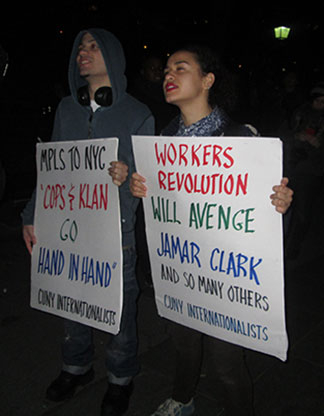 Jamar Clark was victim of racist murder by
Minneapolis police whose chief is part Indian. Native
Americans have been victimized at a higher rate than any other
ethnic group. Right: protest in New York City, 24 November
2015.
Jamar Clark was victim of racist murder by
Minneapolis police whose chief is part Indian. Native
Americans have been victimized at a higher rate than any other
ethnic group. Right: protest in New York City, 24 November
2015.(Internationalist photo)
That underscores the importance of Native American participation in fighting for labor/black mobilization against racist cop terror, for example over the cop murder of Jamar Clark in Minneapolis and Philando Castile in suburban St. Paul. In fact, Native Americans have been victimized by police terror at a higher rate than any other ethnic group.7 No less important is mobilizing in defense of immigrants, particularly in the face of Trump’s threat to deport 11 million (after Obama deported 5.5 million). The demand for full citizenship rights for all immigrants should echo among American Indians who did not win citizenship until 1924, nor the right to practice their traditional religions until 1978, and who even today are disciplined for speaking native languages in school.8 A key demand is for union-scale jobs for Native Americans, to break out of the vicious cycle of welfare programs, poverty, isolation and despair, the root cause of epidemic levels of alcoholism, drug addiction and suicide.
With a strong labor movement, one could generalize union training programs for Native American youth, such as the program hosted by the IBEW electricians union at the United Tribes Technical College in Bismarck, ND. Free university education could be provided by vastly expanding initiatives such as Sitting Bull College at Standing Rock, with open admissions under student-teacher-worker control. A hard-knuckle campaign to unionize oil workers could insist on hiring large numbers of Indian workers in focusing on the need for union safety committees to stop unsafe production in the deadly dangerous Bakken oil fields. But the labor bureaucracy is incapable of waging such a sharp class struggle. Its class collaboration is so ingrained that Laborers Union Local 563, backed by the national AFL-CIO, shamefully sided with Energy Transfer Partners against the Standing Rock Sioux in the fight over the DAPL pipeline.
Defense of oil workers, pipeline workers and Native American workers requires that we dump the sellout labor bureaucrats and break with the Democrats. What’s needed is to build a class-struggle leadership of labor and forge a revolutionary workers party that fights for jobs for all and defends all the oppressed in the struggle to overthrow the dictatorship of capital.
At the same time, life in the Dakotas Indian Country has its own specific character. While Native Americans in the U.S. overwhelmingly live in urban areas, in North Dakota 60% live on five reservations. While nationally, many if not most jobs in “Indian” casinos are held by non-Indians, in the Dakotas 80% of those jobs are filled by Native Americans. Also, a significant minority on the reservations still speak Dakota-Lakota languages. That indigenous ways of life have largely been destroyed as a result of capitalist expansion is a tragic fact. But revolutionary Marxists respect and defend the rights of Native Americans to preserve the cultures that survive. A workers revolution in the U.S., building on the experience of the early Soviet Union, could provide for different forms of autonomy within the framework of the full participation of Native American populations in building a collectivized socialist economy.
Current proponents of “Indian nationalism” put forward the idea that the oppression of native peoples can be overcome through “decolonization,” or some form of separation from U.S. society. But Indian reservations are not colonies, and in fact (as Standing Rock shows) are heavily intertwined with the U.S. economic and political system. The fundamental fact is that U.S. capitalism’s domination of the continent, of which genocide of the indigenous population was a key component, makes “independence” a pipe dream, and a diversion from the task of overthrowing the rapacious capitalist rulers today. Instead of a mythical “return” to a pre-Conquest society, we seek to go forward to a communist future based on the development of modern industry and technology, including energy production. In doing so, the Internationalist Group champions the interests of all of the oppressed, as we strive to build a party that will act, in Lenin’s words, as a “tribune of the people.”
In 2009, the U.S. Congress and President Obama issued an “Apology to Native Peoples of the United States,” saying the U.S. “apologizes … to all Native Peoples for the many instances of violence, maltreatment, and neglect inflicted on Native Peoples by the citizens of the United States.” This hypocritical apology committed the U.S. government to exactly nothing, and didn’t mention stolen Indian lands. In the case of the Dakotas, the theft of the resource-rich Black Hills has been the focus of a legal fight for decades. The region is of cultural importance for the Sioux and Cheyenne (both of whom claim it as the center of the world), and the Fort Laramie Treaty of 1868 had exempted it from white settlement “forever.” In 1980, the Supreme Court concluded in the case of United States v. Sioux Nation of Indians that, “A more ripe and rank case of dishonorable dealings will never, in all probability, be found in our history.”
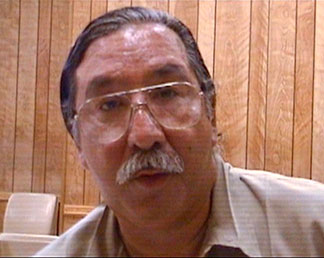 Leonard Peltier, imprisoned
for the last 40 years after being framed by the FBI in its war
on Native Americans: “The only thing I’m guilty of is
struggling for my people.” Free Leonard Peltier!
Leonard Peltier, imprisoned
for the last 40 years after being framed by the FBI in its war
on Native Americans: “The only thing I’m guilty of is
struggling for my people.” Free Leonard Peltier!(Democracy Now!)
The Court ordered the payment of the full value of the land at the time, plus interest, a sum calculated at over $1 billion as of 2011 (which vastly underestimates the value of the gold mined there). However, the Sioux have refused to accept the money as they continue to demand the return of the Black Hills themselves. While overcoming the subjugation of the Native American peoples, including the Dakota and Lakota Sioux, can only come about through workers revolution across North America, that would importantly include some symbolic restitution of stolen lands (along with returning some parts of the Southwest seized from Mexico) in recognition of the crimes of American capitalism. This would surely include returning the Black Hills to the Indian peoples, including Mount Rushmore. The Sioux and Cheyenne can then do with it as they see fit, including effacing it entirely (or at least the sculpture of “Big Stick” imperialist Theodore Roosevelt), or charging nostalgic tourists exorbitant Disneyland-level admissions to view this obscene monument to U.S. imperial glory.
In the meantime, Native Americans are once more under attack, and anyone who calls themselves Marxist must defend them. If the Standing Rock Sioux say they don’t want construction on their ancestral land, all defenders of democratic and Indian rights must join them in demanding that the Dakota Access Pipeline be stopped from crossing the Missouri River there. We also call for the immediate dropping of charges against the more than 500 “water protectors” arrested at Standing Rock, and for freedom for Leonard Peltier, the innocent target of an FBI frame-up in Washington’s unending war on the Native American peoples. Hands off the Standing Rock Sioux! ■
- 1. The League for the Fourth International, of which the Internationalist Group is the U.S. section, has written about the “Indian question” in Latin America as well. See “Marxism and the Indian Question in Ecuador” in The Internationalist No. 17, October-November 2003, where we raise the call for a workers, peasants and Indian’s government in the Andean countries; and “The ‘Other War’ Against the Indigenous Peoples of Oaxaca,” The Internationalist No. 25, January-February 2007.
- 2. See the International Leonard Peltier Defense Committee for more information.
- 3. Gale Courey Toensing, “The Dawes Act Started the U.S. Land-Grab of Native Territory,” Indian Country Media Network, 8 February 2012.
- 4. Peter Capossela, “Impacts of the Army Corps of Engineers’ Pick-Sloan Program on the Indian Tribes of the Missouri River Basin,” Journal of Environmental Law and Litigation, Vol. 30:1, pp. 143-217. Capossela notes that “The Corps located the dams so as to minimize the impact of the reservoirs on the cities along the river in North and South Dakota. The Corps targeted Tribal lands, which were inundated as the sites of the reservoirs.” According to Michael L. Lawson, Dammed Indians: The Pick-Sloan Plan and the Missouri River Sioux, 1944-1980 (1982), “The Oahe Dam [affecting Standing Rock and the Cheyenne River reservation below it] destroyed more Indian land than any other public works project in America.”
- 5. Whether it was building ever-higher levees on the Mississippi River leading to the disastrous Great Flood of 1927; channeling the Mississippi below New Orleans straight into the sea, eliminating wetlands that protected against storm surges; building the Industrial Canal that channeled Katrina flood waters right into New Orleans’ black Lower Ninth Ward, or damming the Missouri River so that it mainly flooded Indian lands, the United States Army Corps of Engineers systematically targeted the poor African American and Native American areas.
- 6. “In North Dakota, a Tale of Oil, Corruption and Death,” New York Times, 30 December 2014.
- 7. See “The Police Killings Nobody Is Talking About,” In These Times, 19 October 2016; and “More Natives Killed By Police Than Any Other Group,” Indian Country Media Network, 18 August 2016.
- 8. In 2012, Miranda Washinawatok was banned from a reservation school basketball team because she was overheard teaching a classmate how to say “hello” and “I love you” in her native language, Menominee.
See also: The Battle Over Standing Rock (7 January 2017)
Pipelines, Oil Trains and Capitalism (7 January 2017)
Spartacist League: Land Surveyor Socialists (7 January 2017)
